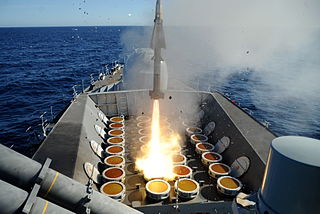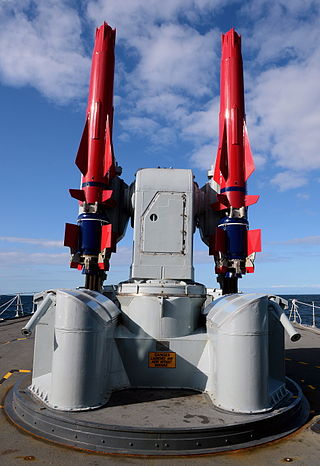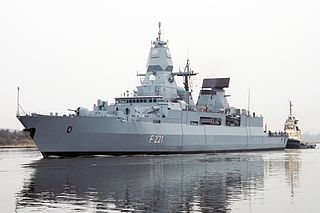
An anti-ship missile (AShM) is a guided missile that is designed for use against ships and large boats. Most anti-ship missiles are of the sea skimming variety, and many use a combination of inertial guidance and active radar homing. A large number of other anti-ship missiles use infrared homing to follow the heat that is emitted by a ship; it is also possible for anti-ship missiles to be guided by radio command all the way.

The Exocet is a French-built anti-ship missile whose various versions can be launched from surface vessels, submarines, helicopters and fixed-wing aircraft.

The County class was a class of British guided missile destroyers, the first such warships built by the Royal Navy. Designed specifically around the Seaslug anti-aircraft missile system, the primary role of these ships was area air defence around the aircraft carrier task force in the nuclear-war environment.

The Aster 15 and Aster 30 are a Franco-Italian family of all-weather, vertical launch surface-to-air missiles. The name "Aster" stands for "Aérospatiale Terminale", with French company Aérospatiale having been the project's lead contractor before its missile activities were merged into MBDA. It also takes inspiration from the word "aster", meaning "star" in Ancient Greek. The missiles as well as the related weapon systems are manufactured by Eurosam, a consortium consisting of MBDA France, MBDA Italy, both with a combined 66% share, and Thales holding 33%.

Sea Wolf is a naval surface-to-air missile system designed and built by BAC, later to become British Aerospace (BAe) Dynamics, and now MBDA. It is an automated point-defence weapon system designed as a short-range defence against both sea-skimming and high angle anti-ship missiles and aircraft. The Royal Navy has fielded two versions, the GWS-25 Conventionally Launched Sea Wolf (CLSW) and the GWS-26 Vertically Launched Sea Wolf (VLSW) forms. In Royal Navy service Sea Wolf is being replaced by Sea Ceptor.

The RIM-7 Sea Sparrow is a U.S. ship-borne short-range anti-aircraft and anti-missile weapon system, primarily intended for defense against anti-ship missiles. The system was developed in the early 1960s from the AIM-7 Sparrow air-to-air missile as a lightweight "point-defense" weapon that could be retrofitted to existing ships as quickly as possible, often in place of existing gun-based anti-aircraft weapons. In this incarnation, it was a very simple system guided by a manually aimed radar illuminator.

The Halifax-class frigate, also referred to as the City class, is a class of multi-role patrol frigates that have served the Royal Canadian Navy since 1992. The class is the outcome of the Canadian Patrol Frigate Project, which dates to the mid-1970s. HMCS Halifax was the first of an eventual twelve Canadian-designed and Canadian-built vessels which combine traditional anti-submarine capabilities with systems to deal with surface and air threats as well. All ships of the class are named after the capital cities most of the Canadian provinces plus the capital of Canada, Ottawa as well as the major cities of Calgary, Montreal, and Vancouver.

Sea Dart, or GWS.30 was a Royal Navy surface-to-air missile system designed in the 1960s and entering service in 1973. It was fitted to the Type 42 destroyers, Type 82 destroyer and Invincible-class aircraft carriers of the Royal Navy. Originally developed by Hawker Siddeley, the missile was built by British Aerospace after 1977. It was withdrawn from service in 2012.

The RIM-162 Evolved SeaSparrow Missile (ESSM) is a development of the RIM-7 Sea Sparrow missile used to protect ships from attacking missiles and aircraft. ESSM is designed to counter supersonic maneuvering anti-ship missiles. ESSM also has the ability to be "quad-packed" in the Mark 41 Vertical Launch System, allowing up to four ESSMs to be carried in a single cell.

The Suffren class were two anti-air frigates of the French Navy, designed to protect a fleet against air threats, surface ships, and submarines. They were the first French ships to be built specifically as guided missile frigates. Ordered in 1960, the class was intended to be more numerous, but budget pressure from the French nuclear weapons program limited their number. The lead ship, Suffren, entered service in 1967 and the second ship, Duquesne, in 1970. They remained in service until the 2000s when they were replaced by ships of the Horizon class.

Suffren was a Suffren-class frigate of the French Navy, designed to protect a fleet against air threats, surface ships, submarines, and, to a lesser extent, provide firepower against land objectives. She is the sister ship of Duquesne, and was decommissioned in 2001. She was the seventh French vessel named after the 18th century admiral Pierre André de Suffren.

Duquesne was a Suffren-class frigate of the French Navy. She was designed to protect a fleet against air threats, surface ships, submarines, and, to a lesser extent, provide firepower against land objectives. She is the sister ship of Suffren. She is the eighth French vessel named after the 17th century admiral Abraham Duquesne. Duquesne was decommissioned in 2008.

The AN/SPG-51 is an American tracking / illumination fire-control radar for RIM-24 Tartar and RIM-66 Standard missiles. It is used for target tracking and Surface-to-air missile guidance as part of the Mk. 73 gun and missile director system, which is part of the Tartar Guided Missile Fire Control System.

Bendix RIM-8 Talos was a long-range naval surface-to-air missile (SAM), among the earliest SAMs to equip United States Navy ships. The Talos used radar beam riding for guidance to the vicinity of its target, and semi-active radar homing (SARH) for terminal guidance. The four antennas surrounding the nose were SARH receivers, which functioned as a continuous wave interferometer. A solid rocket booster provided thrust for launch and a Bendix ramjet powered its flight to the target, with the warhead serving as the ramjet's compressor.

The F124 Sachsen class is the German Navy's latest class of highly advanced air-defense frigates. The design of the Sachsen-class frigate is based on that of the F123 Brandenburg class but with enhanced stealth features designed to deceive an opponent's radar and acoustic sensors. The class incorporates an advanced multifunction radar APAR and a SMART-L long-range radar which is purported to be capable of detecting stealth aircraft and stealth missiles.

Destroyer leader (DL) was the United States Navy designation for large destroyers from 9 February 1951 through the early years of the Cold War. United States ships with hull classification symbol DL were officially frigates from 1 January 1955 until 1975. The smaller destroyer leaders were reclassified as destroyers and the larger as cruisers by the United States Navy 1975 ship reclassification so destroyer escorts could be reclassified as frigates (FF) in conformance with international usage of the term.

The four De Zeven Provinciën-class frigates are air-defence and command frigates in service with the Royal Netherlands Navy. This class of ships is also known as "LCF". The ships are similar to the German Sachsen-class frigates in role and mission.

The RIM-66 Standard MR (SM-1MR/SM-2MR) is a medium-range surface-to-air missile (SAM), with a secondary role as an anti-ship missile, developed for the United States Navy (USN). A member of the Standard Missile family of weapons, the SM-1 was developed as a replacement for the RIM-2 Terrier and RIM-24 Tartar that were deployed in the 1950s on a variety of USN ships. The RIM-67 Standard (SM-1ER/SM-2ER) is an extended range version of this missile with a solid rocket booster stage.

The TF-2000-class destroyer is a projected anti-air warfare guided-missile destroyer currently undergoing development by the Turkish Naval Institute. The class will provide survivability in the presence of aerial threat and also support mission functions such as command, control, and communications, reconnaissance, early warning, surface warfare, anti-submarine warfare and electronic warfare. Moreover, once in service, the TF-2000s are slated to be an integral part of Türkiye's expeditionary strike groups centered around the TCG Anadolu LHD and the country's future aircraft carrier(s). The TCG Anadolu is to be followed up by the TCG Trakya light aircraft carrier and President Erdoğan has also hinted at the construction of a larger aircraft carrier that is to be designed in cooperation with Spain. These capital vessels require destroyer escorts to defend them against enemy aircraft, ships and submarines; in other words, the perfect role for the TF-2000s once these new designs are slated for operational service by 2038. On 5 December 2007, Defence Industry Executive Committee approved plans to build six ships of this class. In January 2013, it was announced that Turkey was planning to acquire a total of 8 TF-2000 destroyers, which was confirmed at the International Defence Industry Fair (IDEF) 2021. With the realization of the project, it is intended to improve the anti-air warfare (AAW) capabilities of the Turkish Navy.

The Mark 41 Vertical Launching System is a shipborne missile canister launching system which provides a rapid-fire launch capability against hostile threats. The Vertical Launch System (VLS) concept was derived from work on the Aegis Combat System.



















